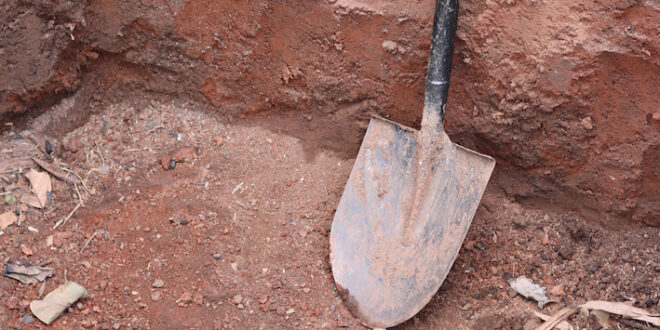We don’t all have a patch of dirt ready to sow and grow. But that doesn’t mean we can’t alter it to turn it into rich soil, and a potentially productive garden. In this article, we check out how to turn poorly draining clay ground into a garden you can rely on.
A natural advantage
Unless your potential garden site is a wetland, or a hollow into which water naturally collects, clay soil structure is usually the reason for poor drainage (check out our previous article, The Low-down on Dirt, to help you decide if you have clay-based soil). But here’s the good news – clay based soils have some big pluses! Not only do they lock-in much needed moisture, but they are usually full of nutrients (because the goodies don’t easily drain away).
If you want to grow hungry, annual plants (such as vegetables), you can take advantage of this, and save yourself work. Instead of trying to improve drainage, simply weed suppress with a layer of non-waxed, chemical-free cardboard, then top it with a 10cm thick layer of compost. Plant your seedlings into the compost. Their roots will establish themselves in it, then grow down through the cardboard and into the clay in order to reach moisture and valuable nutrients. As they do, they will anchor the plant into the ground.
Long term thinking
If you want to establish perennial plants in your clay-based soil, a different approach is required, because the roots of these plants will be in the ground year-round, including over the wettest months. They will also require looser, free-draining soil to stretch out into as they grow. In this case, you will need to alter the structure of your clay.
Working the magician
Clay is water-retentive because its particles are held so tightly together. To introduce drainage and air into, these particles must be forced apart. Garden amendments which force clay particles apart include gypsum, a natural mineral composed of calcium and sulphur. It comes in powder form, and should be sprinkled over your clay at a rate of approximately 1kg per 1sqm of surface area. Dig it into the top 12-15cm of the ground. This won’t bring about instantaneous results (the gypsum will take 2-3 months to do its work, and you may need to make a second application if necessary). As the gypsum acts on the clay, it will also remove nutrients from it – but don’t be too concerned, because stage 2 of your clay-braking magic will make up for it.
Stage 2 – going organic!
Organic matter also helps break apart clay particles. We’re talking here of well-made compost, leaf mulch, untreated calf shed litter (i.e. untreated saw dust which is mixed with animal manure), mushroom compost, and pine needles. Dig any or all of these ingredients into the clay, and leave them to rot down over several months.
Plant power
While you’re waiting for the gypsum and organic matter to do it’s work, sow a hardy green manure crop into the upper surface. Phacelia, lupin, lucern, or buckwheat are all useful for this purpose, depending on the season in which you are sowing. Cut down the green manure crop before it flowers, and dig it back into the ground to provide nutrients and more organic matter.
On the up and up
The more organic ingredients you add to your garden site, the faster the clay will break up, and the better your drainage will become. Unless you live in a particularly dry part of the country (or a region where summer droughts are likely), you can also consider raising your garden above the natural ground level to promote even better drainage. This can be done by building a raised bed using non-treated timber, or by simply mounding up the ground you already have. Beds only need to be raised 8-10cm for plants to really appreciate the difference!
Instead of cursing clay, learn to appreciate it’s positives – and give it the helping hand it needs to perform well for you.











Join the Discussion
Type out your comment here:
You must be logged in to post a comment.